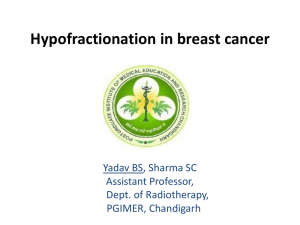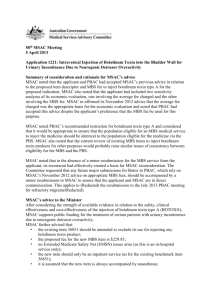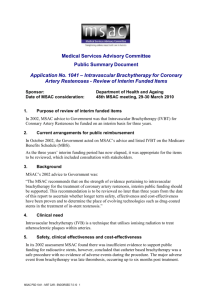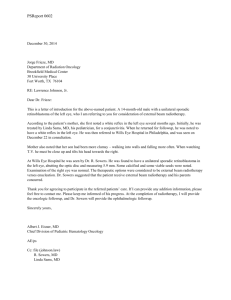Public Summary Document (Word 118 KB)
advertisement
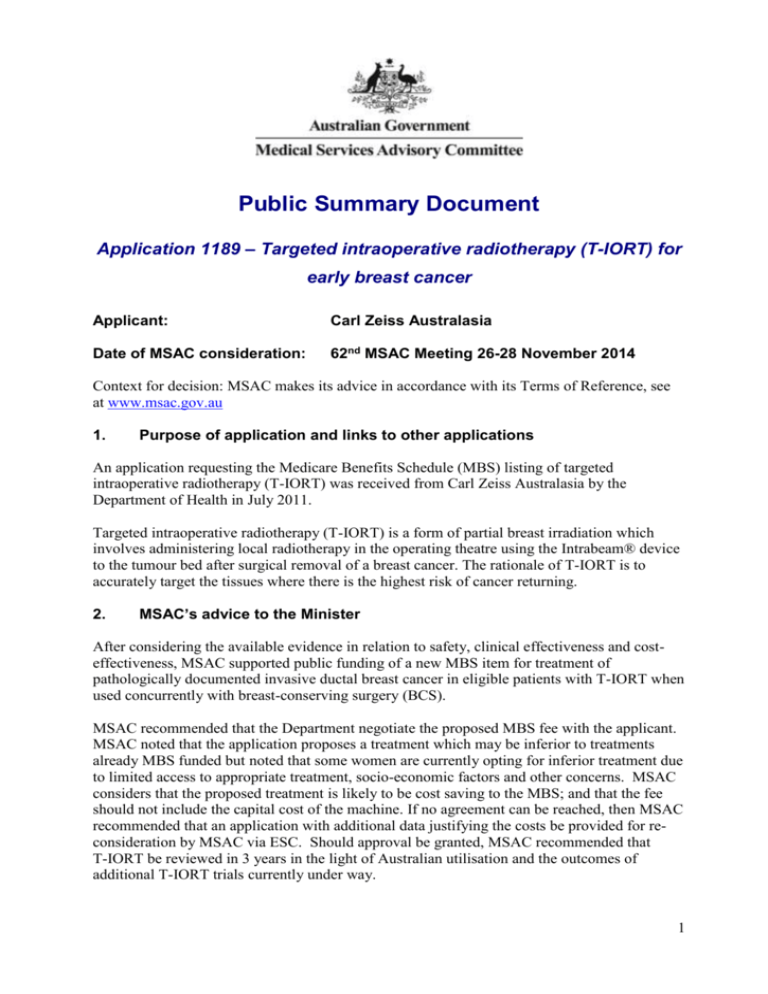
Public Summary Document Application 1189 – Targeted intraoperative radiotherapy (T-IORT) for early breast cancer Applicant: Carl Zeiss Australasia Date of MSAC consideration: 62nd MSAC Meeting 26-28 November 2014 Context for decision: MSAC makes its advice in accordance with its Terms of Reference, see at www.msac.gov.au 1. Purpose of application and links to other applications An application requesting the Medicare Benefits Schedule (MBS) listing of targeted intraoperative radiotherapy (T-IORT) was received from Carl Zeiss Australasia by the Department of Health in July 2011. Targeted intraoperative radiotherapy (T-IORT) is a form of partial breast irradiation which involves administering local radiotherapy in the operating theatre using the Intrabeam® device to the tumour bed after surgical removal of a breast cancer. The rationale of T-IORT is to accurately target the tissues where there is the highest risk of cancer returning. 2. MSAC’s advice to the Minister After considering the available evidence in relation to safety, clinical effectiveness and costeffectiveness, MSAC supported public funding of a new MBS item for treatment of pathologically documented invasive ductal breast cancer in eligible patients with T-IORT when used concurrently with breast-conserving surgery (BCS). MSAC recommended that the Department negotiate the proposed MBS fee with the applicant. MSAC noted that the application proposes a treatment which may be inferior to treatments already MBS funded but noted that some women are currently opting for inferior treatment due to limited access to appropriate treatment, socio-economic factors and other concerns. MSAC considers that the proposed treatment is likely to be cost saving to the MBS; and that the fee should not include the capital cost of the machine. If no agreement can be reached, then MSAC recommended that an application with additional data justifying the costs be provided for reconsideration by MSAC via ESC. Should approval be granted, MSAC recommended that T-IORT be reviewed in 3 years in the light of Australian utilisation and the outcomes of additional T-IORT trials currently under way. 1 MSAC advised that the wording of the proposed MBS item descriptor be tightened to ensure appropriate use, limited to the only currently approved method of T-IORT delivery. 3. Summary of consideration and rationale for MSAC’s advice MSAC noted that this application was for MBS listing of T-IORT, to deliver radiotherapy using the Intrabeam® device to the tumour bed after surgical removal of a breast cancer. The rationale of IORT is to accurately target the tissues where there is the highest risk of cancer recurrence. Patients suitable for this modality should meet the following criteria: aged over 45 years pathologically documented invasive ductal breast cancer T1 or small T2 tumours (less than or equal to 3cm, histologic Grade 1 or 2) are estrogen-receptor positive are node negative suitable for wide local excision for invasive ductal carcinoma that is unifocal on conventional examination and imaging) have no contraindication to breast irradiation MSAC noted the proposal of four new MBS items; two of which relate to the delivery of TIORT by the radiation oncologist and two that cover the additional time required by the surgeon. The proposed MBS item descriptors for T-IORT for pathologically documented invasive ductal breast cancer ESBC are at Section 6. MSAC noted that the proposed MBS item criteria stemmed from the multi-national TARGITA trial upon which this application was based. MSAC noted that the comparator for this intervention was whole breast external beam radiotherapy (WB-EBRT) as it is expected that WB-EBRT would be the intervention most likely to be replaced. It was also noted that subcutaneous mastectomy with or without reconstructive surgery could be another appropriate comparator. MSAC noted that evidence of safety and effectiveness was derived from the results of the TARGIT-A trial, a good-quality, un-blinded, multicentre, non-inferiority randomised controlled trial (RCT) of T-IORT compared to WB-EBRT. Based on the evidence in the TARGIT-A trial, MSAC noted that patients receiving T-IORT were less likely to experience radiotherapy-related toxicity and the rates of major complications were comparable in the two treatment groups. Re-excision rates appeared to be similar across treatment groups (all <10%). MSAC expressed concerns that the proposed population, which is inherently at low risk of local recurrence, represents a subpopulation of the TARGIT-A trial population. MSAC was also concerned that the short duration of follow-up in the TARGIT-A trial may not be sufficient for meaningful evaluation of local recurrence rates and would certainly be insufficient for evaluation of cancer-related mortality. Therefore, for the proposed population, the efficacy of T-IORT was not confidently established compared to WB-EBRT. MSAC noted that while Australian patients accounted for 11% of the TARGIT-A population, the majority (86%) had T-IORT administered post-operatively (“post-pathology”), and this subpopulation had a higher rate of local recurrence. MSAC considered that the evidence did not support the post-pathology use of T-IORT as it was associated with a higher risk of local recurrence. MSAC noted that a cost-minimisation analysis (CMA) was performed based on the TARGITA trial for three scenarios: 2 1. Patients treated with T-IORT concurrent with breast-conserving surgery (BCS) with 15% having three weeks of WB-EBRT as a "boost" based on pathology taken at time of surgery, versus patients treated with BCS followed by six weeks of WB-EBRT. 2. Patients treated with post-pathology T-IORT following BCS, versus patients treated with BCS followed by six weeks of WB-EBRT. 3. Patients treated with T-IORT concurrent with BCS with 15% having three weeks of WB-EBRT as a "boost" based on pathology taken at time of surgery, versus patients undergoing subcutaneous mastectomy followed in 15% of cases by breast reconstruction surgery. MSAC noted that T-IORT yielded cost savings of $5,130, $5,637 and $1,193 per patient in scenarios 1, 2, and 3, respectively. Univariate sensitivity analyses for scenario 1 indicated that the estimated cost saving per patient was reasonably robust. MSAC was concerned that the assumed utilisation of IORT was likely overestimated and the financial implications of public funding – potential total cost savings to the MBS and health budgets – were therefore optimistic. 4. Background MSAC has not previously considered a request to list T-IORT on the MBS for early breast cancer or for any other indication. 5. Prerequisites to implementation of any funding advice The Intrabeam Unit (and spherical applicator) was approved by the Therapeutic Goods Administration (TGA) in 2007. Currently, there are no other T-IORT devices listed on the Australian Register of Therapeutic Goods (ARTG). Prior to the first procedure all service providers are required to have a TARGIT Academy Training Certificate. 6. Proposal for public funding The applicant proposed four new MBS items in total; two for the delivery of T-IORT by the radiation oncologist and two for the additional time required by the surgeon. MSAC recommended two new MBS items for T-IORT. The proposed MBS item descriptor for the provision of T-IORT during BCS by radiation oncologists is provided below. Proposed MBS Item – Provision of T-IORT by Radiation Oncologist Proposed radiotherapy item 15xxx BREAST, MALIGNANT TUMOUR, targeted intraoperative radiotherapy, using an Intrabeam® device, delivered at the time of breast-conserving surgery (partial mastectomy or lumpectomy) for a patient who: a) is 45 years of age or more; and b) has a T1 or small T2 (less than or equal to 3cm in diameter) primary tumour; and c) has a histologic Grade 1 or 2 tumour; and d) has an oestrogen-receptor positive tumour; and e) has a node negative malignancy; and f) is suitable for wide local excision of a primary invasive ductal carcinoma that was diagnosed as unifocal on conventional examination and imaging; and g) has no contra-indications to breast irradiation 3 MBS fee: $TBA MSAC also recommended an additional MBS item, modelled on item 31512, for the surgeon who performs the BCS that recognises the additional time and complexity of BCS with TIORT. Proposed MBS Item – BCS with T-IORT - Surgeon Proposed surgical item xxx BREAST, MALIGNANT TUMOUR, complete local excision of, with or without frozen section histology when targeted intraoperative radiotherapy (using an Intrabeam® device) is performed concurrently, if the requirements of item 15xxx are met for the patient (Anaes.) (Assist.) MBS fee: $TBA Patients suitable for this modality instead of external beam whole breast radiation therapy (WB-WBRT) should meet the following criteria: aged over 45 years; pathologically documented invasive ductal breast cancer; T1 or small T2 tumours (less than or equal to 3cm, histologic Grade 1 or 2); are estrogen-receptor positive; are node negative; suitable for wide local excision for invasive ductal carcinoma that is unifocal on conventional examination and imaging); considered by the surgeon to be suitable for BCS; no contraindication to breast irradiation. Service providers include: (i) (ii) (iii) (iv) (v) Breast surgeons Radiation oncologists Surgical assistant(s) Anaesthetist Medical physicists IORT is delivered by a radiation oncologist. A medical physicist is also required in order to calibrate the device. 7. Summary of Public Consultation Feedback/Consumer Issues Consumers supported the proposal noting that it could be expected to lead to greater access and equity for rural and remote patients. MSAC noted advice that women were more likely to opt for six weeks of radiotherapy following breast cancer surgery if they lived near a radiotherapy centre. T-IORT provides a viable option for patients who do not live near a radiotherapy centre as treatment can be provided during surgery. Consumers noted that the creation of new MBS items will enable monitoring to inform further (comparative) research and policy review. Consumers acknowledged that current evidence does not support a higher MBS reimbursement but supported the service being funded while further evidence is being gathered. 4 8. Proposed intervention’s place in clinical management The Protocol for this submission based assessment was developed by the applicant with advice from the Department of Health and PASC, and is included in Section A of the submission. The clinical management algorithm from this Protocol is shown at Figure 1. Figure 1: Clinical management algorithm – including proposed service NBCC Recommended follow-up schedule 1-2 Years 3-5 Years After 5 Years History & Exam Every 3 months Every 6 months Every year Mammography (& ultrasound if indicated) At 6-12 months after radiotherapy for conserved breast Every year Every year Chest X-ray: Only if clinically indicated Bone Scan, blood count & biochemistry: Only if clinically indicated 9. Comparator The applicant’s submission nominated WB-EBRT as the main comparator. It is expected that WB-EBRT is the intervention most likely to be replaced. The treatment course of WB-EBRT normally starts after the tissues have healed within 4 – 6 weeks after BCS. According to the applicant, patients most commonly receive WB-EBRT treatments once a day, five days a week, for a total of six weeks. In Australia, WB-EBRT treatments are usually delivered using a linear accelerator in a radiation oncology facility in an outpatient setting. The cost of the service is covered by the MBS and patient out-of-pocket expenses while the cost of certain equipment, such as linear accelerators and planning systems, is funded via the Radiation Oncology Health Program Grants (ROHPG). 5 10. Comparative safety Overall, the rates of major complications were comparable in the two treatment groups. However, patients receiving T-IORT were less likely to experience radiotherapy-related toxicity. The critique noted that, although re-excision rates appeared to be similar across treatment groups and the strata (all <10%), MBS data indicate that re-excision may occur in up to 20% of women having BCS. The implication of this is that, in clinical practice, a higher proportion of patients with unclear margins will go on to receive WB-EBRT after T-IORT although MSAC noted that this re-excision rate was unlikely to apply to the patient group for T-IORT. Pre-modelling studies: The submission presented an outline of the clinical pathways of the TARGIT-A trial and the approach taken in the economic evaluation. The critique noted that this could be viewed as an applicability issue, although it is insufficiently presented. Several translation issues which warrant pre-modelling studies are not presented in the submission, these include: 11. Discussion around the population and circumstances of use reflected in the economic evaluation, and how this compares with that presented in Section A. Consideration of the distribution of patients in the TARGIT-A trial and how this compares with expected clinical practice in Australia. In particular, demonstrating whether the split of pre-pathology and post-pathology patients in the study is representative of how radiotherapy is used in Australia (both currently and in the event of a listing for T-IORT) is necessary to show whether the scenarios presented in the economic evaluation are appropriate. The applicability of the results of the TARGIT-A trial to the requested listing/modelled population. In particular, an assessment of the different results observed in the two strata of the TARGIT-A trial (pre-pathology and post-pathology) should be presented and discussed in Section C, as this impacts on the validity (or otherwise) of the scenarios used in the economic evaluation. The applicability of Scenario 3 in Section D that considers T-IORT versus subcutaneous mastectomy. Without adequate discussion to demonstrate its validity, and support for a claim of non-inferiority, Scenario 3 is not justified. Presentation of evidence, or at least support for an assumption, to demonstrate that the use of T-IORT in tandem with a six-week regimen of supplemental WB-EBRT is noninferior to six weeks of WB-EBRT. In the absence of a justification of this, it is difficult to consider that the approach used in Scenario 1 is supportable. The Assessment Report does not discuss the applicability of the six-week regimen at all. Comparative effectiveness The primary source of evidence for this application was the TARGIT-A study: a good quality, un-blinded, multicentre non-inferiority RCT that compared T-IORT using the Intrabeam device with conventional WB-EBRT. A total of 3,451 women with early breast cancer were recruited from 33 centres in 11 countries, including two sites in Australia. The primary outcome of the TARGIT-A RCT was absolute difference in local recurrence in the conserved breast, with a pre-specified non-inferiority margin of 2.5% at five years. The trial was launched in 2000 and the planned follow-up for trial participants was at least 10 years. However, the median follow-up in the most recent publication (Vaidya et al. 2014) was two years and five months, with 59% of participants (N=2,020) achieving a median four years and 35% (N=1,222) achieving a median five years of follow-up. The mature cohort of 2,232 6 patients, which was originally reported in a 2010 publication, had a median follow-up of three years and seven months (IQR 30-61 months). T-IORT was delivered concurrently, immediately after surgical excision under the same anaesthesia, in approximately two-thirds of the patient population (pre-pathology stratum, n=2,298) and as a subsequent procedure after definitive tumour pathology reports in remaining patients (post-pathology stratum, n=1,153). The two participating Australian sites enrolled 394 patients, representing 11% of the total TARGIT-A population. Importantly, the majority of Australian patients (86% in the 2010 publication) were enrolled in the post-pathology stratum, accounting for 34% of all post-pathology patients. The trial used a “risk-adapted approach” in that, if participants randomised to T-IORT were subsequently found to have unfavourable adverse pathology findings (such as unexpected lobular carcinoma, extensive intraductal component, positive margins at first excision), and hence were at high risk of ipsilateral recurrence, they received supplemental EBRT (i.e. TIORT+WB-EBRT). Approximately 15% of patients (N=239) in the T-IORT group (combining both pre-pathology and post-pathology strata) received T-IORT+WB-EBRT. However, the proportion of patients randomised to the pre-pathology stratum and post-pathology stratum who received both treatments was approximately 19% and 3%, respectively. Approximately 21% of all patients randomised to T-IORT (approximately one in five patients) received treatment in the form of mastectomy or WB-EBRT. The results were analysed using an intention-to-treat (ITT) approach, including all patients randomised, according to the initial treatment assigned, regardless of whether they received and/or completed the treatment. The initial 2010 publication reported that 66% of study participants received hormone therapy, 12% received chemotherapy, 4% received ‘other’ adjuvant therapies and 8% were unknown, with no differences overall between arms in the overall study population. Other differences from proposed population (IORT group, 2014 paper appendices): 12% tumours >2cm (unknown 10%) 15% grade >2 (unknown 11%) 17% LN involvement (unknown 9%) 8% ER neg (unknown 9%) The results for five-year risk of local recurrence (the primary outcome) and mortality (overall, breast cancer-related and non-breast cancer-related) is shown in Table 1. The five-year risk for local recurrence in the conserved breast in the whole cohort of patients was higher in patients receiving T-IORT compared with WB-EBRT but the absolute difference did not exceed the pre-defined non-inferiority margin of 2.5%. With the statistical significance level pre-specified at p<0.01 for recurrence, the difference between groups was not statistically significant. Table 1 Results of 5-year risk of local recurrence and deaths across the direct randomised trial Clinical outcomes TARGIT-A (2014) All patients Local recurrence Death Breast cancer mortality Non-breast cancer mortality T-IORT n with event/N (%) [95% CI] WB-EBRT n with event/N (%) [95% CI] Absolute difference in Kaplan-Meier estimate at 5 years (%) p-value 23/1679 (3.3% [2.1-5.1]) 37/1721 (3.9% [2.7-5.8]) 20/1721 (2.6% [1.5-4.3]) 17/1721 (1.4% [0.8-2.5]) 11/1696 (1.3% [0.7-2.5]) 51/1730 (5.3% [3.9-7.3]) 16/1730 (1.9% [1.1-3.2]) 35/1730 (3.5% [2.3-5.2]) 12 (2.0%) -14 (-1.4%) 4 (0.7%) -18 (-2.1%) 0.042 0.099 0.56 0.0086 7 Clinical outcomes T-IORT n with event/N (%) [95% CI] WB-EBRT n with event/N (%) [95% CI] Absolute difference in Kaplan-Meier estimate at 5 years (%) Pre-pathology stratum Local recurrence 10/1107 (2.1% [1.1-4.2]) 6/1127 (1.1% [0.5-2.5]) 4 (1.0%) Death 29/1140 (4.6% [1.8-6.0]) 42/1158 (6.9% [4.3-9.6]) -13 (-2.3%) Breast cancer mortality 17/1140 (3.3% [1.9-5.8]) 15/1158 (2.7% [1.5-4.6]) 2 (0.6%) Non-breast cancer mortality 12/1140 (1.3% [0.7-2.8]) 27/1158 (4.4% [2.8-6.9]) -15 (-3.1%) Post-pathology stratum Local recurrence 13/572 (5.4% [3.0-9.7]) 5/569 (1.7% [0.6-4.9]) 8 (3.7%) Death 8/581 (2.8% [1.3-5.9]) 9/572 (2.3% [1.0-5.2]) -1 (0.5%) Breast cancer mortality 3/581 (1.2% [0.4-4.2]) 1/572 (0.5% [0.1-3.5]) 2 (0.7%) Non-breast cancer mortality 5/581 (1.58% [0.6-4.0]) 8/572 (1.76% [0.7-4.4]) -3 (-0.18%) Abbreviations: CI, confidence interval; T-IORT, intraoperative radiotherapy; WB-EBRT, external beam radiotherapy. p-value 0.31 0.12 0.72 0.016 0.069 0.67 0.35 0.32 In the pre-pathology stratum, the absolute difference in recurrence did not exceed the 2.5% non-inferiority margin and the difference between groups was not statistically significant. However, in the post-pathology stratum, the five-year risk of local recurrence was higher in TIORT patients compared with conventional WB-EBRT and the non-inferiority margin was exceeded. Therefore, T-IORT concurrent with BCS is non-inferior to WB-EBRT in reducing local recurrence whereas T-IORT given as a second procedure (post-pathology) is inferior to WB-EBRT. A Cox model (see Section B.6 of the Critique) found that age, tumour grade, lymphovascular invasion and nodal status did not appear to have any influence on local recurrence, while the timing of T-IORT (pre-pathology versus post-pathology) and progesterone receptor (PgR) status were significant predictors of local recurrence. 12. Economic evaluation The applicant submission presented a cost-minimisation analysis (CMA) based on the TARGIT-A trial. As outlined in Section C, the CMA comprises three scenarios: Scenario 1: Patients treated with T-IORT concurrent with BCS plus 15% having three weeks of WB-EBRT as a boost based on pathology taken at the time of surgery versus patients treated with BCS followed by six weeks of WB-EBRT. Scenario 2: Patients treated with T-IORT as a separate procedure post BCS and pathology versus patients treated with BCS followed by six weeks of WB-EBRT. Scenario 3: Patients treated with T-IORT concurrent with BCS plus 15% having three weeks of WB-EBRT as a boost based on pathology taken at the time of surgery versus subcutaneous mastectomy followed by breast reconstruction surgery for 15% of patients having a subcutaneous mastectomy. A simple CMA estimated the total cost of each treatment modality in each of the three scenarios. Costs are accrued until the final treatment in each of the identified scenarios. The results of each scenario presented in the economic evaluation are shown in tables ES.3-ES.5. The critique noted that the CMA is only appropriate in cases in which a claim for noninferiority can be supported. However, the pivotal study, reports a non-inferior result for what is equivalent to Scenario 1 only. It also suggests there are issues with the Scenario 1 analysis. In particular, the use of a three-week regimen for the supplemental WB-EBRT radiotherapy is not justified as non-inferior in the Assessment Report. 8 Scenario 1 - Results of the economic evaluation Treatment T-IORT arm WB-EBRT arm Incremental BCS $8,686.06 $6,021.71 $2,664.35 WB-EBRT $2,152.36 $9,946.23 -$7,793.87 Total $10,838.42 $15,967.94 -$5,129.52 Abbreviations: BCS, breast conserving surgery; T-IORT, targeted intraoperative radiotherapy; WB-EBRT, whole breast external beam radiotherapy Scenario 2 - Results of the economic evaluation Treatment T-IORT arm WB-EBRT arm Incremental BCS $6,024.51 $6,024.51 $0.00 Radiotherapy $4,309.23 $9,946.23 -$5,637.00 Total $10,333.74 $15,970.74 -$5,637.00 Abbreviations: BCS, breast conserving surgery; T-IORT, targeted intraoperative radiotherapy; WB-EBRT, whole breast external beam radiotherapy Scenario 3 - Results of the economic evaluation Treatment T-IORT arm Mastectomy arm Incremental Primary procedure a $8,689.56 $9,906.50 -$1,216.94 b Subsequent procedures/treatment $1,280.70 $1,256.60 $24.10 Total $9,970.26 $11,163.10 -$1,192.84 Abbreviations: T-IORT, targeted intraoperative radiotherapy; WB-EBRT, whole breast external beam radiotherapy a BCS and concurrent T-IORT in the T-IORT arm, subcutaneous mastectomy in the subcutaneous mastectomy arm b Supplemental WB-EBRT in the T-IORT arm, breast reconstruction in the subcutaneous mastectomy arm The critique also presented the results of the univariate sensitivity analyses presented in the Assessment Report (patient through-put and decreased capital and service costs). Due to the uncertainty around the non-inferiority claim in both Scenario 2 and Scenario 3, only Scenario 1 is considered in the sensitivity analyses. Scenario 1 - Results of sensitivity analyses Univariate analyses T-IORT arm WB-EBRT arm Incremental Base case $9,970.26 $15,970.74 -$6,000.48 Patient through-put reduced from 224 patients to 112 patients $10,879.06 $15,970.74 -$5,091.68 10% decrease in capital costs, such that the unit cost of the Intrabeam $9,912.86 $15,970.74 -$6,057.88 capital & service equals $851.40 10% decrease in service fee, such that the unit cost of the Intrabeam $9,936.78 $15,970.74 -$6,033.96 capital & service equals $875.32 Supplemental WB-EBRT assumed to use six-week regimen $10,837.95 $15,970.74 -$5,132.79 All T-IORT patients assumed to undergo supplemental WB-EBRT $14,618.74 $15,970.74 -$1,352.00 All T-IORT patients assumed to undergo supplemental WB-EBRT and $18,635.79 $15,970.74 $2,665.05 use a six-week regimen Private insurer-source unit costs in T-IORT arm increased by 10% $10,548.30 $15,970.74 -$5,422.44 Abbreviations: T-IORT, targeted intraoperative radiotherapy; WB-EBRT, whole breast external beam radiotherapy 13. Financial/budgetary impacts The total average cost of T-IORT per patient for Scenario 1 (T-IORT concurrent with BCS) was estimated to be $9,970 ($8,690 cost of BCS concurrent with T-IORT plus $1,281 cost of 3 weeks of supplementary WB-EBRT in 15% of patients). In comparison, the total average cost for six weeks of WB-EBRT was $15,971 ($6,025 for BCS plus $9,946 for WB-EBRT). 9 For Scenario 2 (delayed T-IORT), the total average cost per patient is estimated to be $10,334 ($6,025 cost of the BCS plus $4,309 cost of T-IORT as a separate procedure). As for Scenario 1, the total average cost per patient for the comparator is $15,971. For Scenario 3, the total average cost of T-IORT per patient is $9,970 (same as for Scenario 1) but the total average cost per patient of the comparator is $11,163 ($9,907 for the subcutaneous mastectomy plus $1,257 for breast reconstruction in 15% of patients). Thus, the use of T-IORT is potentially associated with cost savings which arise from lower utilisation of WB-EBRT and mastectomy. The estimated number of patients undergoing T-IORT (which is equivalent to the number of procedures) for the first five years of an MBS listing is shown below. These estimates include an estimate of the potential number of women who choose to ‘swap’ from mastectomy to BCS with T-IORT. Estimated eligible population of patients Description 2015 2016 2017 2018 2019 Number of T-IORT procedures - based on 10% annual growth of BCS 198 436 970 2,133 4,759 Number of T-IORT procedures - based on 5% annual growth of BCS 181 379 805 1,691 3,600 Number of patients swapping mastectomy with BCS a 0 41 120 280 489 Number of patients swapping mastectomy with BCS b 0 82 240 Abbreviations: BCS; breast conserving surgery; T-IORT; targeted intraoperative radiotherapy. a Swapping Scenario 1 assumes 2% in Year 2, 5% in Year 3, 10% in Year 4 and 15% in Year 5. b Swapping Scenario 2 assumes 4% in Year 2, 10% in Year 3, 15% in Year 4 and 20% in Year 5. 420 652 The estimated net financial impact to the combined MBS and OPHG budget of listing T-IORT for the treatment of early stage breast cancer are based on the applicant’s original average cost per patient, and do not use the recalculated costs from the Critique. The applicant did not provide separate estimates of cost to the MBS over time. Total MBS and OPHG budget saving in the first 5 years of MBS listing Description 2015 2016 2017 2018 2019 Scenario 1 MBS & OHPG Budget saving – 10% growth of BCS $1,509,855 $3,324,731 $7,396,764 16,265,255 $36,289,897 MBS & OHPG Budget saving – 5% growth of BCS $1,380,221 $2,890,076 $6,138,552 $12,894,771 $27,451,908 MBS & OHPG Budget saving – 10% growth of BCS $1,609,126 $3,543,328 $7,883,093 $17,334,678 $38,675,917 MBS & OHPG Budget saving – 5% growth of BCS $1,470,969 $3,080,095 $6,542,155 $13,742,588 $29,256,840 Scenario 2 Scenario 3 MBS & OHPG Budget costs $0 $45,364 $132,772 $309,800 $541,044 Abbreviations: BCS, breast conserving surgery; MBS, Medicare Benefits Schedule; OPHG, Radiation Oncology Health Program Grant; WB-EBRT, whole breast external beam radiotherapy. 14. Key issues from ESC for MSAC ESC noted the proposed eligible population is a subpopulation of the trial population (women aged over 45 years; T1 or T2 but less than or equal to 3cm; grade 1 or 2; node negative and ER positive). There was no subgroup analysis to support safety and efficacy in this population. 10 ESC also noted that Australian women participating in the study were predominantly in the post-pathology stratum, in which IORT was found to be associated with an increased rate of ipsilateral recurrence compared to WB-EBRT. ESC agreed that the MBS item descriptor should align with the inclusion criteria for the key trial. ESC considered that the evidence did not support the post-pathology use of T-IORT as it was less effective than WB-EBRT in reducing local recurrence. ESC noted that the median follow-up time in the trial was two years and five months. ESC was concerned that the short duration of follow-up may not be sufficiently long for a meaningful evaluation of local recurrence and cancer-related mortality in this low-risk group. ESC also noted the Faculty of Radiation Oncology’s views opposing early adoption without a minimum of 10 years of follow-up data. ESC was concerned that the cost of treatment had been not been calculated consistently in the trial arms. However, ESC noted that mortality within each group (whether overall or cancer-related) was not significantly different between IORT & WB-EBRT, although it conceded that mortality was higher in the pre-pathology than the post-pathology group (this is of uncertain significance) ESC noted that the non-inferiority claim is based on a 2.5% margin. The landscape for the claim of non-inferiority may have changed significantly since this margin was based on an estimated 5-year local recurrence rate of 6% derived from older trial data. The trial started recruiting patients in the early 2000s and, over the decade of the study, outcomes have improved. ESC expressed doubt regarding the continued relevance of the 2.5% margin. ESC noted that a cost-minimisation analysis based on the TARGIT-A trial with three scenarios was used. ESC considered that this approach was not appropriate for two of the scenarios (scenario 2 – post-pathology stratum, and scenario 3 - subcutaneous mastectomy), as non-inferiority had not been demonstrated for those scenarios. ESC was also concerned that there were no pre-modelling studies to support some economic claims. ESC noted that the applicant’s submission was based on the applicant’s preferred protocol which diverges from the advice of the protocol advisory subcommittee (PASC). ESC noted that the total savings to MBS and health budgets may be over-estimated due to a range of uncertainties in the estimates of potential utilisation, including: - access to services due to substantial capital and service cost for the device; - capacity of the healthcare system to provide the service; - patient choice, given the risk of local recurrence with no overall mortality benefit; and - Australian centres’/clinicians’ likelihood of adopting T-IORT, due to the poor performance of the post-pathology stratum (favoured by Australian study sites). ESC noted that the proposed MBS item criteria stemmed from the multi-national trial upon which this application was based. ESC noted that the trial did not specify peri or postmenopausal women, but that it specified women aged 45 years and over. 11 ESC noted that the proposed item descriptor is too broad and leaves access open to other forms of IO radiotherapy. 15. Other significant factors Nil. 16. Applicant’s comments on MSAC’s Public Summary Document This Public Summary, due to page limitation constraints, cannot adequately reflect the weight of evidence supporting the use of Targeted intraoperative radiotherapy (T-IORT) for early breast cancer. Please refer to the two main papers published in the Lancet reporting on the key clinical trial, TARGIT-A Randomised Trial - Vaidya et al 2010 & Vaidya et al 2014. 17. Further information on MSAC MSAC Terms of Reference and other information are available on the MSAC Website at: www.msac.gov.au. 12


